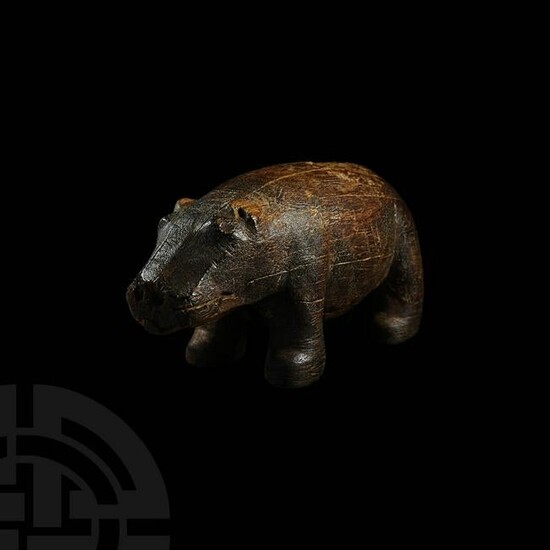Large Egyptian Wooden Hippopotamus Figurine
Late Middle Kingdom-Second Intermediate Period, 1803-1550 BC. A wooden figure carved in the round as a standing hippopotamus, the ears, eyes and tail picked out in raised relief, shaped muzzle and detailing to nostrils and mouth, circular hole to the sole of each foot for attachment. Cf. a wooden hippopotamus figurine found at Abu Rawash in the funerary temple of Djedefre, king of the 4th Dynasty, and now preserved in Cairo Museum (JdE 35140) (Behrmann, 1989, Dok. 65; Posener-Krieger, 1991, pp. 297-298; Roche 2014, p. 84); see Behrmann, A., Das Nilpferd in der Vorstellungswelt der Alten Ägypter. Teil I, Katalog, Frankfurt am Main – Berlin – Paris, 1989; Lacovara, P., 'A New Date for an Old Hippopotamus', Journal of the Museum of Fine Arts, Boston 4, 1992; Posener-Krieger, P., 'Quelques pièces du matériel cultuel du temple funéraire de Rêneferef', MDAK 47, 1991; Roche, A., 'Et le roi tua l'hippopotame. Enquête sur les origines d'un rite égyptien', Archimède : archéologie et histoire ancienne 1, 2014. 330 grams, 17cm (6 3/4"). From an important London W1, collection; ex Croisier collection (inv no. A 2004-0017/dt); formerly with Galerie Samarcande, Paris, in 1989; accompanied by an academic report by Dr Alberto Maria Pollastrini; this lot has been checked against the Interpol Database of stolen works of art and is accompanied by AIAD certificate number no.10988-181280. In Egyptian mythology, the hippopotamus is an animal full of metaphoric meanings: on one hand, this big semiaquatic mammal is an agent of resurrection, representing the sun rising from the primordial waters; on the other, when associated with the benevolent goddesses Taweret and Hedjet, it becomes a symbol of fecundity and birth. Such figurines in wood are rare. [A video of this lot is available to view on Timeline Auctions Website]
Condition Report: Fine condition, split and chipped underneath.
View it on
Estimate
Time, Location
Auction House
Late Middle Kingdom-Second Intermediate Period, 1803-1550 BC. A wooden figure carved in the round as a standing hippopotamus, the ears, eyes and tail picked out in raised relief, shaped muzzle and detailing to nostrils and mouth, circular hole to the sole of each foot for attachment. Cf. a wooden hippopotamus figurine found at Abu Rawash in the funerary temple of Djedefre, king of the 4th Dynasty, and now preserved in Cairo Museum (JdE 35140) (Behrmann, 1989, Dok. 65; Posener-Krieger, 1991, pp. 297-298; Roche 2014, p. 84); see Behrmann, A., Das Nilpferd in der Vorstellungswelt der Alten Ägypter. Teil I, Katalog, Frankfurt am Main – Berlin – Paris, 1989; Lacovara, P., 'A New Date for an Old Hippopotamus', Journal of the Museum of Fine Arts, Boston 4, 1992; Posener-Krieger, P., 'Quelques pièces du matériel cultuel du temple funéraire de Rêneferef', MDAK 47, 1991; Roche, A., 'Et le roi tua l'hippopotame. Enquête sur les origines d'un rite égyptien', Archimède : archéologie et histoire ancienne 1, 2014. 330 grams, 17cm (6 3/4"). From an important London W1, collection; ex Croisier collection (inv no. A 2004-0017/dt); formerly with Galerie Samarcande, Paris, in 1989; accompanied by an academic report by Dr Alberto Maria Pollastrini; this lot has been checked against the Interpol Database of stolen works of art and is accompanied by AIAD certificate number no.10988-181280. In Egyptian mythology, the hippopotamus is an animal full of metaphoric meanings: on one hand, this big semiaquatic mammal is an agent of resurrection, representing the sun rising from the primordial waters; on the other, when associated with the benevolent goddesses Taweret and Hedjet, it becomes a symbol of fecundity and birth. Such figurines in wood are rare. [A video of this lot is available to view on Timeline Auctions Website]
Condition Report: Fine condition, split and chipped underneath.



